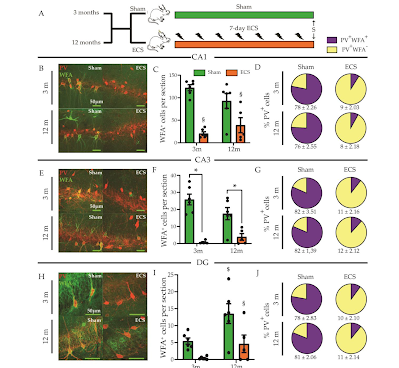ECS Neuronal Effects Differ With Age: New Study in Int J Neuropsychopharmacology
Out on PubMed, from investigators in India and the USA (Yale), is this study:
Influence of chronic electroconvulsive seizures on plasticity-associated gene expression and perineuronal nets within the hippocampi of young adult and middle-aged Sprague-Dawley rats.
Int J Neuropsychopharmacol. 2023 Mar 4:pyad008. doi: 10.1093/ijnp/pyad008. Online ahead of print.PMID: 36879414
The abstract is copied below:
Background: Electroconvulsive seizure therapy is often used in both treatment-resistant and geriatric depression. However, preclinical studies identifying targets of chronic electroconvulsive seizure (ECS) are predominantly focused on animal models in young adulthood. Given that putative transcriptional, neurogenic and neuroplastic mechanisms implicated in the behavioral effects of chronic ECS themselves exhibit age-dependent modulation, it remains unknown whether the molecular and cellular targets of chronic ECS vary with age.
Methods: We subjected young adult (2 - 3 months) and middle-aged (12 - 13 months), male Sprague Dawley rats to sham or chronic ECS, and assessed for despair-like behaviour, hippocampal gene expression, hippocampal neurogenesis, and neuroplastic changes in the extracellular matrix, reelin and perineuronal net (PNN) numbers.
Results: Chronic ECS reduced despair-like behavior at both ages, accompanied by overlapping and unique changes in activity-dependent and trophic factor gene expression. Whilst chronic ECS had a similar impact on quiescent neural progenitor numbers at both ages, the eventual increase in hippocampal progenitor proliferation was substantially higher in young adulthood. We noted a decline in reelin⁺ cell numbers following chronic ECS only in young adulthood. In contrast, an age-invariant, robust dissolution of PNNs that encapsulate parvalbumin⁺ neurons in the hippocampus was observed following chronic ECS.
Conclusion: Our findings indicate that age is a key variable in determining the nature of chronic ECS evoked molecular and cellular changes in the hippocampus. This raises the intriguing possibility that chronic ECS may recruit distinct, as well as overlapping, mechanisms to drive antidepressant-like behavioural changes in an age-dependent manner.
Keywords: PNN; aging; antidepressant; hippocampal neurogenesis; hippocampus; parvalbumin; reelin.
The article is here.
And from the text:
1) to show that there remains intense interest in further understanding the mechanism of action of ECT and 2) that ECT's brain effects may differ by age. The latter might be some (probably small) part of the explanation of why older patients do even better with ECT. Note that Ron Duman is a co-author.







Comments
Post a Comment